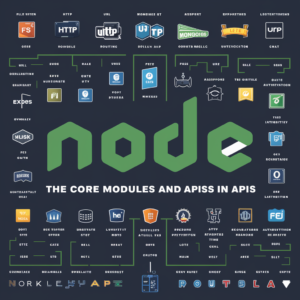Node.js is a powerful and popular JavaScript runtime environment that allows you to run JavaScript code on the server side. It’s built on Chrome’s V8 JavaScript engine and has gained immense popularity for its ability to handle real-time, data-intensive applications. This article will introduce you to Node.js, its runtime environment, and guide you through installing and setting up your development environment. We’ll also cover running your first Node.js script.
What is Node.js?
Node.js is an open-source, cross-platform runtime environment that enables developers to execute JavaScript code outside of a web browser. Traditionally, JavaScript was limited to client-side scripting, running within the user’s browser. Node.js, however, brings JavaScript to the server side, allowing developers to build scalable and efficient network applications.
Key Features of Node.js:
- Event-Driven Architecture: Node.js operates on a non-blocking, event-driven architecture, making it ideal for building I/O-bound applications like web servers.
- Asynchronous I/O: Node.js uses asynchronous, non-blocking I/O operations, allowing multiple tasks to run concurrently without waiting for each other.
- Single-Threaded: Despite being single-threaded, Node.js can handle thousands of concurrent connections efficiently thanks to its event loop.
- Rich Ecosystem: Node.js has a vast ecosystem of libraries and modules available through npm (Node Package Manager), making development faster and more efficient.
Understanding the Node.js Runtime Environment
The Node.js runtime environment consists of several components that work together to execute JavaScript code outside the browser. The most critical parts of this environment are:
- V8 JavaScript Engine: Node.js is built on Chrome’s V8 engine, which compiles JavaScript directly to native machine code, providing high performance.
- Event Loop: The event loop is a key feature of Node.js, responsible for handling asynchronous operations. It allows Node.js to perform non-blocking I/O operations, making it highly efficient in handling multiple tasks simultaneously.
- Node.js API: Node.js provides a rich set of APIs that facilitate file system interactions, networking, and more, making server-side development with JavaScript straightforward and efficient.
Installing Node.js and Setting Up Your Development Environment
Before you can start working with Node.js, you’ll need to install it on your machine. Follow these steps to get started:
- Download Node.js:
- Visit the official Node.js website.
- You’ll find two versions available: LTS (Long-Term Support) and the latest version. For stability, it’s recommended to download the LTS version unless you need the latest features.
- Install Node.js:
- Follow the installation instructions for your operating system (Windows, macOS, or Linux). The installation process will also install npm, the Node Package Manager, which is essential for managing Node.js packages.
- Verify Installation:
- After installation, open your terminal (Command Prompt for Windows, Terminal for macOS/Linux) and type the following commands to verify the installation:
node -v
npm -v
- These commands will display the installed versions of Node.js and npm, confirming that the installation was successful.
Running Your First Node.js Script
With Node.js installed, you’re ready to run your first script. Follow these steps to create and execute a simple Node.js script:
- Create a New File:
- Open your code editor and create a new file named
app.js.
- Open your code editor and create a new file named
- Write Your Script:
- Add the following code to your
app.jsfile:
- Add the following code to your
console.log('Hello, Node.js!');
- This script simply prints “Hello, Node.js!” to the console.
3. Run the Script:
- Save the file and open your terminal.
- Navigate to the directory where your
app.jsfile is located. - Run the script using the following command:
node app.js
- You should see the message “Hello, Node.js!” printed in the terminal, indicating that your script ran successfully.
Conclusion
In this article, we’ve introduced you to Node.js, explained its runtime environment, and walked you through the installation and setup process. We’ve also covered running your first Node.js script, which marks the beginning of your journey into server-side JavaScript development. Node.js is a versatile and powerful tool, and as you continue learning, you’ll discover its full potential in building fast, scalable, and efficient applications.
Tags
Nodejs, #JavaScript, #RuntimeEnvironment, #EventDriven, #AsynchronousProgramming, #V8Engine, #NonBlockingIO, #ServerSideDevelopment, #npm, #InstallationGuide, #FirstScript, #WebDevelopment, #BackendDevelopment





